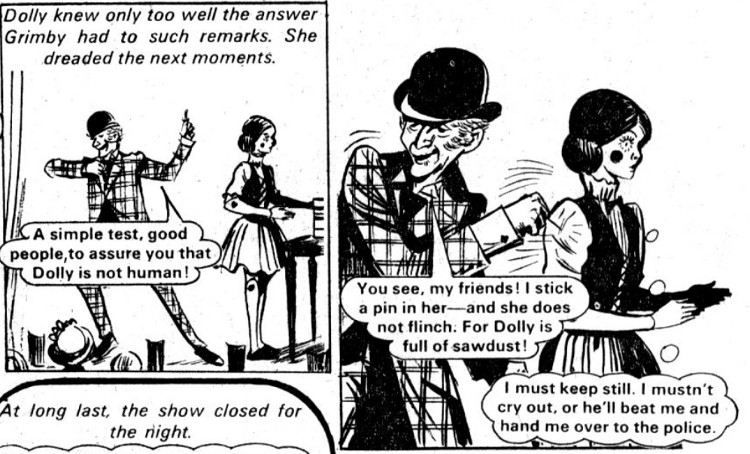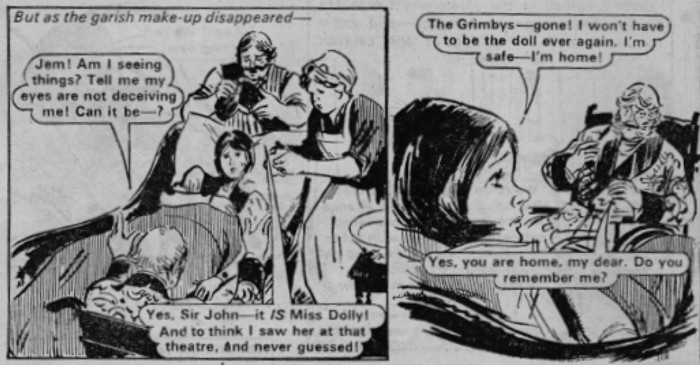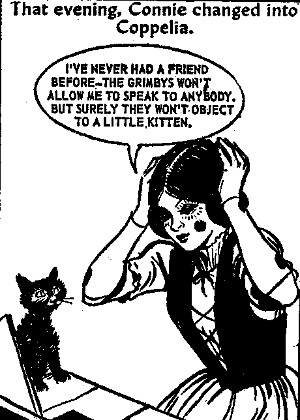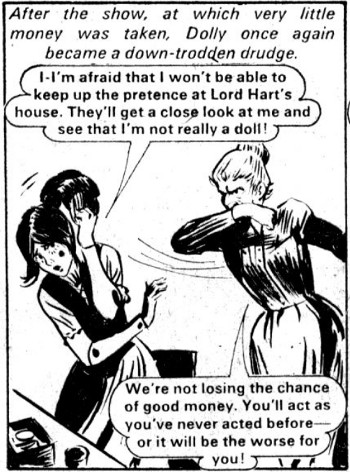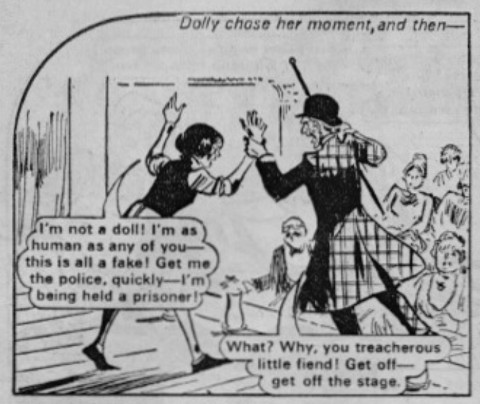- The Double Life of Coppelia Brown – Mandy: #128 (28 Jun 1969) – #138 (06 September 1969)
- Reprinted as The Double Life of Dolly Brown – Mandy: #482 (10 April 1976) – #492 (19 August 1976)
- Reprinted as The Double Life of Coppelia Brown – Mandy #818 (18 September 1982) – #828 (27 November 1982)
- Reprinted as The Double Life of Dolly Brown – Mandy #1188 (21 October 1989) – #1198 (30 December 1989)
- Reprinted as The Double Life of Dolly Brown (as Mandy Classic) – M&J: #297 (18 January 1997) – #307 (29 March 1997)
Plot
Note: The main character went by different names in different prints of the story, in this summary, I’ll just refer to her as the most commonly used “Dolly Brown”
In Victorian times, traveling around fairs Gus Grimby shows off his amazing mechanical doll invention that can walk, talk and obey commands with no strings attached. Although if the audience could look closer, they would see it was actually a girl in makeup, straining to stay still and not blinking. While not on stage Dolly Brown is forced to slave for Gus and Ma Grimby. Dolly cannot remember her past, but has been told by the Grimbys that she committed a crime and she owes them as they protect her from being sent to prison. A torn wanted poster with her picture convinces her that they are telling the truth, and she must stay being a puppet.
Despite her hard life and supposed criminal past, Dolly still shows kindness to others like pretending to freeze up on stage to point out a thief, being kind to an ill girl or rescuing a kitten, even though it risks punishment later . She is forced by the Grimbys to give a way the kitten to an audience member. The recipient comes back to thank the doll and seeing servant girl, Dolly, the family seem to think she looks familiar, whether they are recognising her as doll or from some place else is unclear, beginning the mystery of who really is Dolly Brown.
Dolly gets a clue to her past when she helps an injured girl during a storm, the girl seems to recognise her when she says “Dolly! Willow Wood..”. Dolly doesn’t get a chance to see the girl again to question her more, as the police move the Grimbys on. This also raises doubts about the Grimby’s honesty regarding Dolly’s past. Gus Grimby tells Dolly they had to move on because the police were sent after the girl recognising her, but Dolly had overheard the actual conversation, that the police is moving them on because the squire doesn’t want fairs on his land so she knows he is lying.
In the meantime she continues with her double life. She stills shows kindness to others, although she finds out not everyone is deserving of it. She is tricked by a girl into borrowing the dolls shoes, but the girl then tries to sell them, luckily they are returned but that doesn’t stop Dolly getting a beating and the Grimbys implying she was in on the scheme being a criminal herself. She never gets any sympathy from the Grimbys, even when she is sick they ignore her suffering and force her to continue to perform. When she does collapse, not wanting to lose their source of outcome they do temporarily get better lodgings and someone to look after her. After waking up from her fever in a comfortable bed, a confused Dolly first asks if she is at Willow Wood. The woman looking after her remembers a story about Willow Wood, that a child disappeared from there, alongside valuables.
Not wanting to miss a good money opportunity, the Grimbys head towards Maybury, where Dolly supposedly committed her crime. Ma Grimby is nervous about being so close to there and tells Dolly to keep out of sight. Dolly can’t stay hidden when a fire breaks out at a nearby tent and she rescues a baby, a comment from crowd says she has look of a gentry family named Harding. Deciding to investigate further thinking that Willow Wood must be close by Dolly takes an opportunity to sneak off to look for it. She locates the large house and immediately recognizes it, but before she can look around, the groundskeeper spots her and drives her away, assuming she’s there to pry into others’ misfortunes. Later that evening, the man goes to view the show, Dolly thinks he has recognised her, until realising it is Gus Grimby he is looking at. After the show the man confronts Gus Grimby, as Dolly is still dressed as a doll, Gus is forced to let her stay. The man, Gem Baker claims he remembers him from the night Grimby and his gang robbed Willow Wood. Grimby ever the charming con man, weasels out of it claiming it was his brother that he must have seen. Having heard it all Dolly believes they were all part of robbery.
When they are asked to do longer show, Dolly knows she must endure if she is to stay in Maybury and find out more about her past. Dolly investigates further and she meets a girl, Susie, who’s mother now works at Willow Wood. She feels the house is familiar and a feeling of happiness, when she hears the story of the robbery, that Mr Harding was struck down and crippled during the robbery and the housekeeper’s daughter disappeared at the same time, she concludes she must be that girl who betrayed her mother and Mr Harding by letting the thieves in.She doesn’t wait for Susie to tell her the rest of the story.
Having enough of her double life and wanting to atone for her crimes, she decides to turn herself in to the police. Suspicious, Ma Grimby catches her and stops her, when Dolly tells them she knows she was daughter of the housekeeper who betrayed Mr Harding, the Grimbys suddenly act nicer to her. Later she hears them say that they are safe as she still doesn’t remember who she is, they plan to keep a closer eye on her and board up her room’s window. Dolly is surprised she still doesn’t know who she is, but she won’t keep up this life any more and with no other option, in the middle of the act on stage she shouts out for help and give up the ruse.
The Grimbys make a quick get away with her, but crash the caravan. Cutting their losses they leave the unconscious Dolly for dead and get away. Dolly wakes and makes her way to Willow Wood, knowing she will be safe there. Collapsing at the house when her makeup is removed, she is revealed to be Mr Harding’s granddaughter. She had seen the robbery and lost her memory with the shock of seeing him struck down. The Grimbys kidnapped her so she wouldn’t be able to give evidence against them. Finally home her memories come back, the Grimbys are found and arrested and Dolly packs away her doll costume never having to live double life again, but she will not forget her time, and those less fortunate than her.
Thoughts
Clearly a well received story, as it was reprinted 4 times. In the original story the girl’s name was Connie Brown, and the doll was named Coppelia. The doll’s name and title clearly a reference to the Coppélia ballet, where a man becomes infatuated with a mechanical doll that an inventor has created and his previous love, dresses up as the doll to rescue him. In the reprint the name is switched to Dolly Brown, the next reprint has the title changed back to Coppelia Brown again, but oddly in this case the girl is no longer called Connie, instead both her and the doll are called Coppelia. The next two reprints they keep with the Dolly Brown name.
As with other stories, we see variants pop up, such as The Secret of Penny Farthing where a girl is blackmailed into pretending to be a ventriloquist dummy or Ballerina on a String where a girl performs as a dancing puppet. Due to being one of the first or perhaps because of its many reprints, this story is one that sticks in the mind more. There is also added mystery in this story, as Dolly has amnesia and we don’t know who she is or what she supposedly did. Throughout the story and Dolly’s acts of kindness, despite her own circumstances, the reader must find it hard to believe that she could have committed such a terrible crime. Meanwhile the Grimbys are deceitful, cruel guardians, forcing her to perform and slave for them, beating on her when she doesn’t meet their standards. When the truth comes out, that not only are they blackmailing her with the crime they committed, but also that they kidnapped her from a loving home, they certainly rank top among the despicable villains to appear in these comics.
The build up of clues to Dolly’s past and wondering if she will ever be free of her false life keeps readers engaged. When Dolly finally decides to break away, going to turn herself in to the police, there is one more obstacle as the Grimbys stop her, and it seems she is trapped again. Revealing herself on stage makes for a more exciting climax and the panicked escape with the Grimbys taking Dolly, it is relief to see her finally escape their clutches and get her happy ending. As with a lot of theses older stories, there is a panel of info dump explaining how Dolly ended up with the Grimbys, but overall an exciting and satisfying conclusion to the story.
